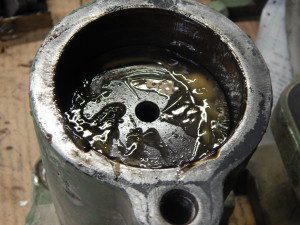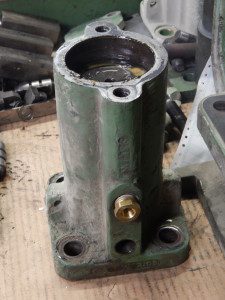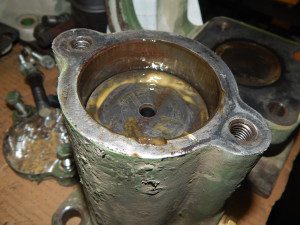We often have customers send our products back for routine maintenance checks and to address functionality problems they are experiencing. A customer sent us their 1350 VMS impact vibrator used on a railcar to unload dry cement. We typically recommend a lightweight oil lubricant for our pneumatic vibrators. In the pictures below, you can see that our customer used grease. This is a major no-no and will only lead to premature failure of the vibrator. Our air piston vibrators carry fairly tight tolerance between the piston O.D. and the body I.D. This tolerance can be as small as tenths of a thousand to just a few thousand. If you add anything to the air stream that changes that tolerance, you may affect the performance of the vibrator.
(Photos of 1350 VMS Piston Vibrator returned to Cleveland Vibrator)
The VIBRA-LUBE MXR-12 that we recommend using will create an air mist or fog for keeping the vibrator lubricated but isn’t thick or heavy enough to change the tolerance of the vibrator. The lighter oil will also allow foreign matter and impurities to pass through the piston ports, around the piston, and exit through the exhaust ports. It is crucial not to partially block a porting hole or create build-up between the piston and bore. This could end up jamming the pneumatic vibrator, which can lead to product failure in the field. The heavier lubricants tend to trap foreign matter in the ports and around the piston, and as a result, could reduce the life of your vibrator.
Many types of lubricants are used in the industry, and some can be used in multiple applications. But, in our opinion, not when it comes to pneumatic vibrators. They may seem to work for the short term but will cause more harm than good in the long haul. Over the years, we’ve seen folks use many types of lubricants in air vibrators to include the following:
- Grease of several different types
- LPS
- Kerosene
(Yes, you read right, we said kerosene) - 30 Weight and Heavier Motor Oil
- WD40
- Penetrating Oil
- Hard to imagine but totally true, Graphite Spray
(Which isn’t too bad if you could bake it in the bore) - And my favorite… Straight WATER!
Most of us have probably been in that situation where you are ready to use something such as a lawnmower, and it calls for an oil gas mix. You may not have the manual handy on the oil gas mix and simply guess, or you don’t have the factory suggested oil, so you look around and find a quart of 30 weight PENN-OIL you’ve had in your garage since 1965, and figure oil is oil and how different can it be? Hey, if it works for Arnold Palmer in his John Deere tractor, why wouldn’t it also work in an old lawnmower? Probably after three hours of pulling on the starter rope and an arm almost falling off, you will have thought, “Maybe I should have read the instructions or taken the time to purchase the correct oil”. Lesson learned.
To help our customers achieve successful results and run our products at top-notch performance, we have added VIBRA-LUBE to many of our pneumatic vibrator kits at part of the startup to help with proper lubrication at the beginning. We normally recommend the 10W/NR as our standard. However, there are others for extreme cold conditions, food service safety grade, and many others that fit our product’s application.
In short, with proper greasing, you can extend the longevity of the product substantially. But, with haphazard methods, perhaps just accept that the vibrator will experience failure sometime down the line. It’s best to consult us before you go about greasing up your industrial pneumatic vibrators. Please never hesitate to reach out to a member of our team; we are here and happy to help!
Follow us:
Share this blog post:






2 Responses to The Top 8 Lubricants You Shouldn’t Use on Your Industrial Pneumatic Vibrator